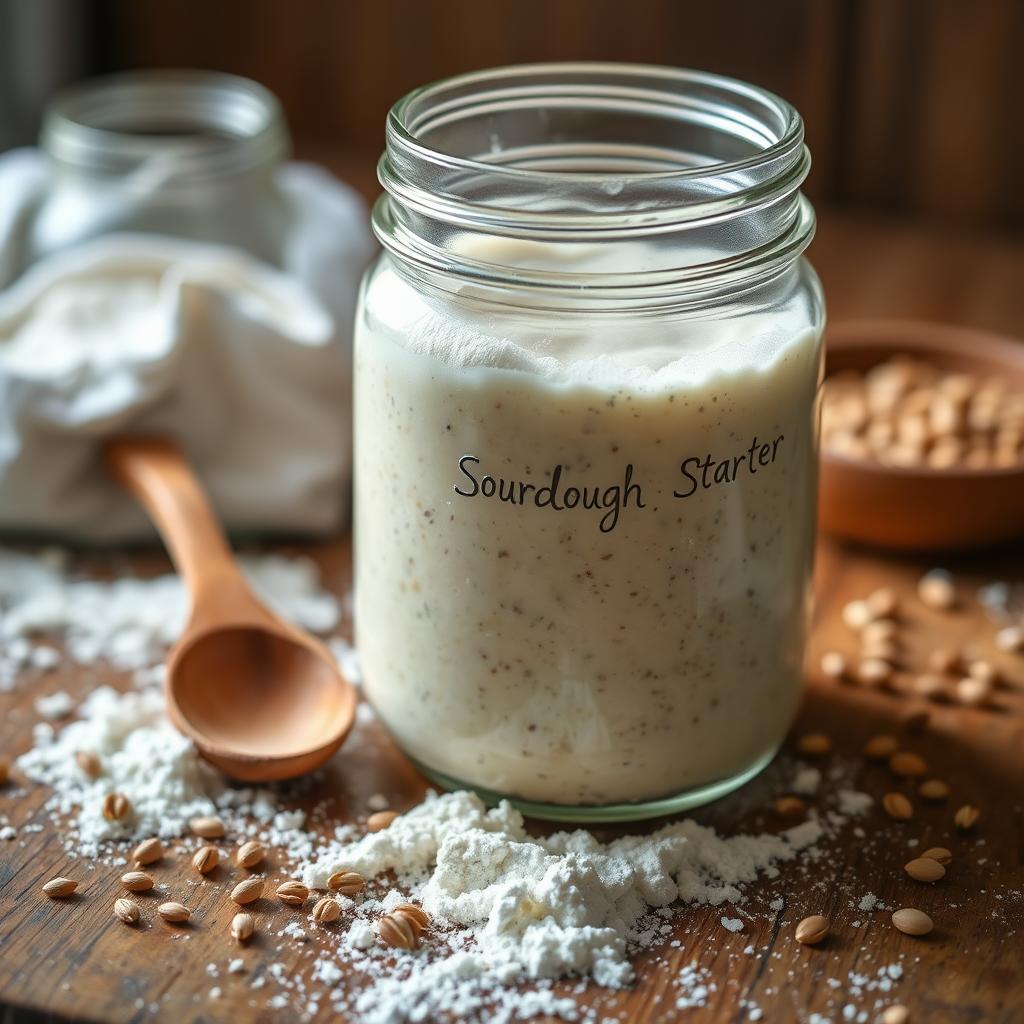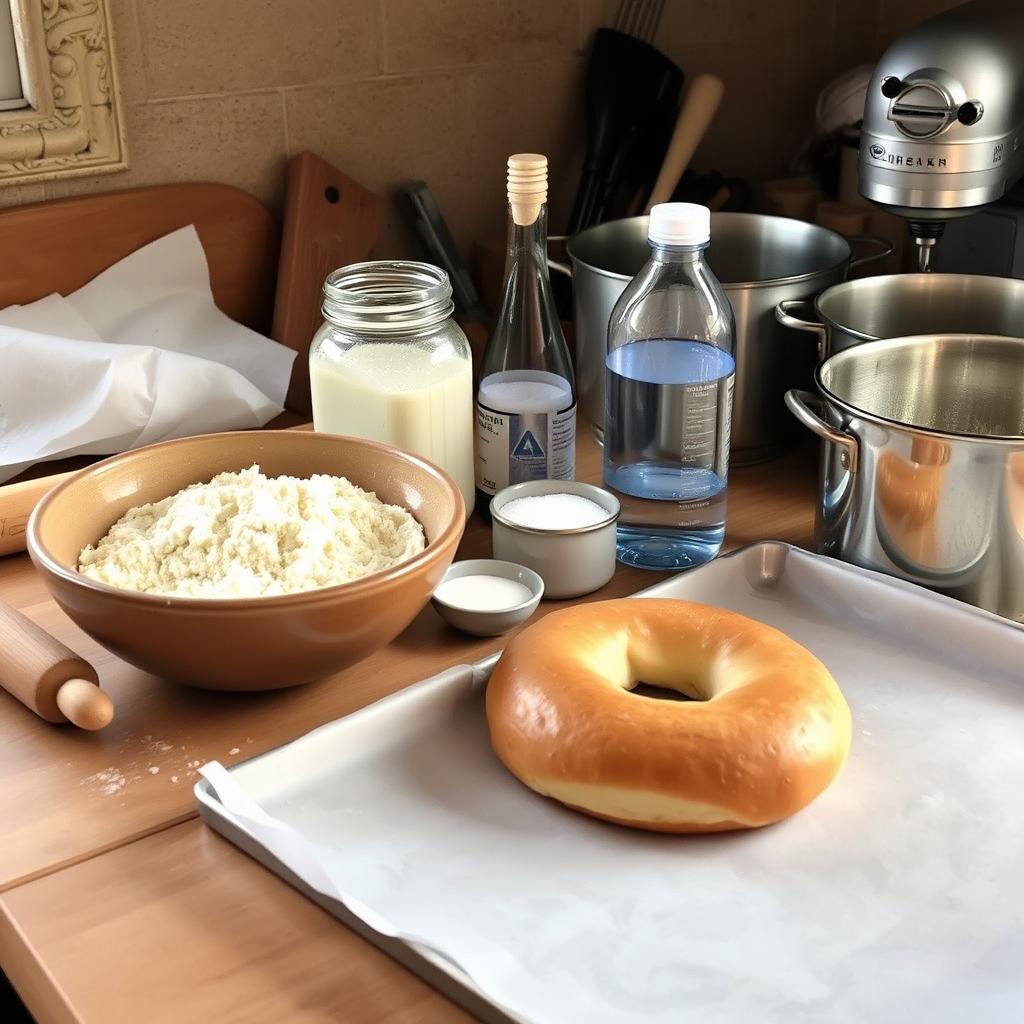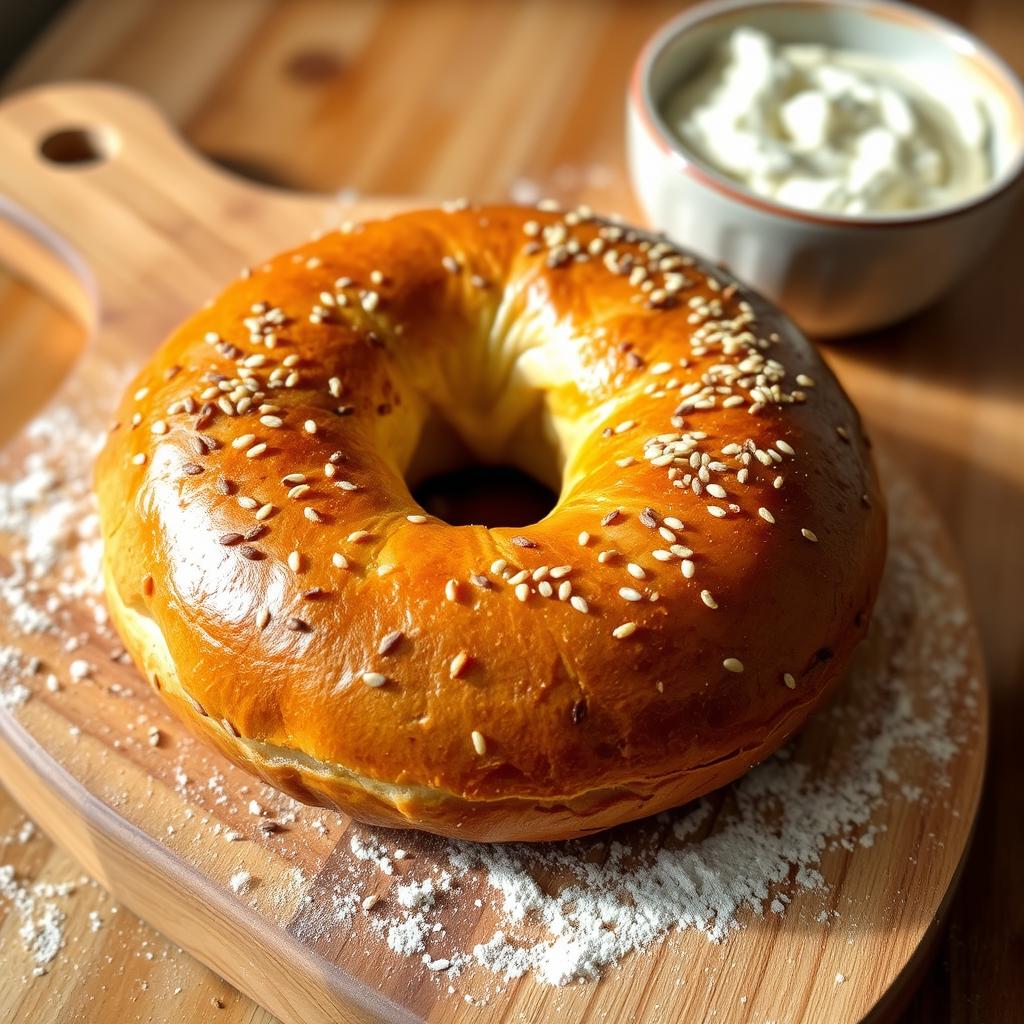Ever had a freshly baked sourdough bagel recipe? The smell alone takes you to a cozy bakery. I’ve mastered making these treats at home and I’m excited to share my tips with you. Get ready to learn how to make delicious sourdough bagel recipe bagels in your kitchen.
Making sourdough bagels is a labor of love, but it’s so rewarding. The sourdough bagel recipe starter gives them a unique tang and chew. In this guide, you’ll learn how to make sourdough bagels, from starting your starter to baking them perfectly.
Whether you’re an experienced baker or new to the kitchen, this article will help you. Imagine making these treats for your loved ones or starting your own bagel business. Let’s start making perfect sourdough bagels that everyone will love.

Key Takeaways
- Sourdough bagels offer a unique flavor and texture compared to traditional yeast-based bagels.
- Mastering the art of sourdough starter cultivation is crucial for achieving the perfect bagel dough.
- Proper shaping, proofing, and boiling techniques are essential for creating the classic bagel shape and chewy interior.
- Experimenting with various toppings and mix-ins can elevate your homemade sourdough bagels to new heights.
- Patience and attention to detail are key to consistently baking delicious sourdough bagels at home.
Understanding Sourdough Starter Basics
Making sourdough bagels starts with knowing sourdough bagel recipe making and artisan bread starters. The sourdough starter is key. It’s a mix of wild yeast and bacteria that adds flavor and chewiness to your dough.
Creating Your Own Sourdough Starter
Starting your sourdough starter is a journey of patience and watching. Mix equal parts flour and water to create a home for microorganisms. Keeping your starter fed and healthy is essential for its success.
Maintaining Starter Health
- Feed your starter every 12-24 hours to keep it lively.
- Keep it in a clean container at room temperature, out of sunlight.
- Throw away some starter before feeding to keep it balanced.
Signs of Active Starter
A healthy starter will show signs like bubbles, a sour smell, and growing size after feeding. These signs mean your starter is ready to enhance your sourdough bagels.
Learning about sourdough starters is the first step to making perfect homemade sourdough bagel recipe at home.

Essential Ingredients and Equipment for Bagel Making
Making perfect sourdough bagels at home needs careful picking of ingredients and the right tools. Whether you’re an experienced baker or new to bagel baking instructions, knowing the basics is key for tasty, bakery-like results.
For fermented dough recipes like sourdough bagels, the base is high-quality flour. Choose bread flour or all-purpose flour with 11-13% protein. This ensures the chewy texture that’s a bagel’s hallmark.
- Bread flour or all-purpose flour (11-13% protein content)
- Sourdough starter (active and bubbly)
- Salt (kosher or sea salt)
- Water (at room temperature)
- Honey or malt syrup (optional for sweetness)
You’ll also need some key tools for a smooth bagel baking process:
- Large mixing bowl for kneading the dough
- Dough scraper or bench knife for handling the dough
- Baking sheets or pizza stones for baking the bagels
- Parchment paper or silicone baking mats for lining the baking sheets
- A large pot for boiling the bagels
- Slotted spoon or skimmer for transferring the bagels from the boiling water

“The key to making perfect sourdough bagels at home lies in using the right ingredients and tools. With the proper equipment and a little practice, you can recreate the authentic taste and texture of your favorite bakery bagels.”
The Complete Sourdough Bagel Recipe
Making sourdough bagels at home is a fun and rewarding journey. It lets you create tasty, fresh treats with a special flavor. To make the perfect sourdough bagel, you need to know the right ingredients, how to mix them, and the first fermentation steps. Let’s explore the full recipe and learn how to make your own sourdough bagel recipe that will wow your loved ones.
Ingredient Measurements and Ratios
Getting the right ingredient amounts and ratios is key for great results. For about 8 sourdough bagels, you’ll need:
- 250g active sourdough starter
- 375g bread flour
- 225g water
- 10g salt
- 1 tsp sugar (optional)
Mixing and Kneading Instructions
Start by mixing the sourdough starter, flour, water, salt, and sugar (if using) in a big bowl. Use a strong spoon or your hands to mix until it’s a shaggy dough. Then, put the dough on a floured surface and knead for 10-15 minutes. It should become smooth, elastic, and pass the “windowpane test.”
Initial Fermentation Guidelines
After kneading, put the dough in a lightly oiled bowl. Cover it with a damp cloth or plastic wrap. Let it ferment at room temperature for 8-12 hours, or until it doubles in size. This step is important for developing the sourdough flavor and texture in your fermented dough recipes.
By sticking to these exact measurements, mixing methods, and fermentation times, you’re on your way to making the ultimate sourdough bagel. It will satisfy your cravings and delight your taste buds.
Mastering the Art of Bagel Shaping
Making the perfect sourdough bagel is more than just ingredients and baking. Shaping the dough into uniform rounds is key. Learn the shaping techniques for bagels that look great and bake evenly.
The Traditional Rope Method
The rope method is a classic bagel baking instruction. Roll out dough into a long rope. Then, bring the ends together to form a circle, sealing the seam.
The Punch-and-Poke Technique
For a unique look, try the punch-and-poke method. Start with a round dough ball. Poke a hole through the center, widening it as you rotate. This keeps the bagel even.
“Consistent shaping is key for even baking and a professional finish.”
Choose your method wisely. Handle the dough gently to keep it chewy. This is crucial for your bagels.
With practice, you’ll shape bagels like a pro. Try different shaping techniques to find your favorite. This will help you achieve the perfect bagel.
Proofing Techniques for Perfect Texture
To get the perfect texture in your homemade sourdough bagels, you need to master proofing. This step is key to making your bagels light and airy, or dense and chewy. Let’s look at the two main proofing methods and how to know when your dough is ready.
Room Temperature vs. Cold Proofing
Choosing between room temperature and cold proofing affects your bagel’s texture. Room temperature proofing, which takes 1-2 hours, makes the dough rise and flavor develop fast. This method gives a chewier, more sourdough taste.
Cold proofing, however, lets the dough ferment in the fridge for 12-24 hours. It makes the dough more delicate and slightly tangy. It also strengthens the gluten, making the bagel better structured and rise better during baking.
Visual Cues for Proper Proofing
- Gently poke the dough with your finger. If it springs back slowly, it’s ready for the next step.
- Look for the dough to have increased in volume by approximately 30-50%.
- Observe the dough’s surface – it should appear slightly shiny and have a smooth, even texture.
By paying attention to these signs, you can make sure your sourdough bagel dough is proofed right. This will give you the perfect texture and crumb structure.
The Crucial Boiling Process
Learning to boil bagels is key to making perfect sourdough bagels at home. This step improves the bagels’ texture and look. It also makes them chewy and crusty.
Before baking, each bagel dough needs a quick boil. This step sets the bagels’ shape and makes them shiny and chewy. The sourdough bagel recipe suggests boiling them for 1 minute on each side in hot water.
Keep the water between 212°F and 215°F for the best results. Don’t let it boil too hard, or your bagels will be tough. Adding barley malt syrup or baking soda to the water can also improve taste and look.
| Boiling Step | Recommended Time | Water Temperature |
|---|---|---|
| Boil one side | 1 minute | 212°F – 215°F |
| Boil the other side | 1 minute | 212°F – 215°F |
After boiling, put the bagels on a baking sheet. Then, bake them as the recipe says. This step is crucial for a perfect mix of chewiness and crispiness.
“The boiling process is the secret to achieving that classic bagel texture – chewy yet with a crisp, shiny crust. It’s a simple step that makes all the difference.”
Baking Temperature and Timing Guidelines
Mastering sourdough bagel baking needs precise temperature and timing. To get a golden crust and chewy inside, you must understand oven management and baking techniques. Follow these tips to improve your baking bagels and bagel baking instructions.
Start by preheating your oven to 450°F (230°C). This high heat helps create a crispy outside and a soft inside. Place the bagels on the oven rack or a parchment-lined baking sheet.
Bake the bagels for 12-15 minutes. Watch them closely for a golden-brown crust. Rotate the baking sheet halfway to ensure even browning.
For a final step, broil the bagels for 1-2 minutes. This adds color and crispness to the crust, making it irresistible.
Oven temperatures and times can vary. Keep an eye on the bagels and adjust the time as needed for your desired result.
| Step | Temperature | Time |
|---|---|---|
| Preheat Oven | 450°F (230°C) | – |
| Bake Bagels | 450°F (230°C) | 12-15 minutes |
| Broil | Broil Setting | 1-2 minutes |
By following these baking bagels and bagel baking instructions, you’ll make stunning sourdough bagels. Enjoy the homemade bagel perfection!
Popular Bagel Toppings and Variations
Make your homemade sourdough bagels even better by trying different toppings. You can go for classic choices like sesame and poppy seeds. Or, you can get creative with unique flavor mixes. The options are endless for customizing your bagels.
Classic Topping Combinations
Stick with the classics for a timeless taste. Sprinkle sesame or poppy seeds on your bagels for a crunchy, nutty flavor. For something more savory, mix garlic powder, onion powder, and coarse sea salt. This blend adds a robust, flavorful touch.
Applying Toppings Properly
To get your toppings to stick, apply them at the right time. Brush the boiled bagels with egg wash or milk first. Then, sprinkle your toppings generously. This method ensures your toppings stick well, making your bagels look and taste great.

